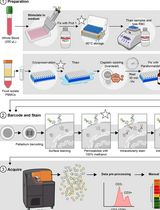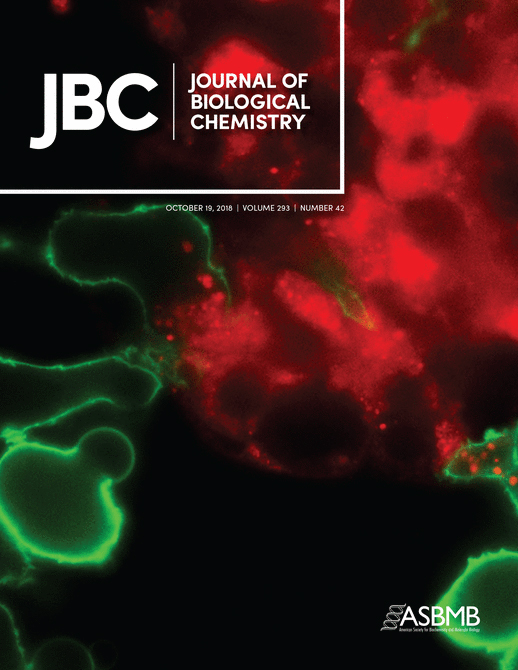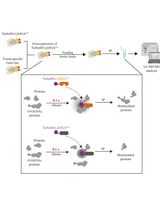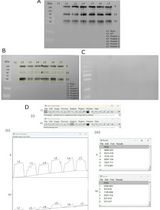- EN - English
- CN - 中文
A Radioactive in vitro ERK3 Kinase Assay
体外ERK3激酶的放射性分析
发布: 2019年08月20日第9卷第16期 DOI: 10.21769/BioProtoc.3332 浏览次数: 6659
评审: Chiara AmbrogioMauro Sbroggio'Enrico Patrucco

相关实验方案

用于比较人冷冻保存 PBMC 与全血中 JAK/STAT 信号通路的双磷酸化 CyTOF 流程
Ilyssa E. Ramos [...] James M. Cherry
2025年11月20日 2129 阅读
Abstract
Mitogen-activated protein kinases (MAPKs) are serine/threonine kinases that have an important role in signal transduction. Extracellular signal-regulated kinase 3 (ERK3), also known as MAPK6, is an atypical MAPK. Here, we describe in detail an in vitro assay for the kinase activity of ERK3 using myelin basic protein (MBP) or steroid receptor coactivator-3 (SRC-3) as substrates. The assay is carried out in the presence of [γ-32P]-ATP which results in radiolabeling of phosphorylated substrates. Separation of the reaction components by gel electrophoresis followed by autoradiography enables detection of the radiolabeled products, and hence determination of the kinase activity of ERK3. This assay can be used for several applications including identification of substrates, determination of the effect of molecules or mutations on kinase activity, and testing specific kinase inhibitors. Furthermore, the protocol outlined here can be adapted to measure the activity of other kinases by using their specific substrates.
Keywords: ERK3 (ERK3)Background
Extracellular signal-regulated kinase 3 (ERK3) is an atypical mitogen-activated protein kinase (MAPK) (Coulombe and Meloche, 2007). Here we describe an in vitro kinase assay in which ERK3 transfers radiolabeled gamma-phosphate from [γ-32P]-ATP to a purified protein substrate. Excess radiolabeled ATP is then separated from the radiolabeled substrate by gel electrophoresis. The amount of phosphorylated substrate can be quantified by autoradiography, phosphorimaging, or liquid scintillation counting techniques. Radioactive kinase assay provides a direct measurement of kinase activity. It is sensitive, quick, inexpensive, and considered as the 'gold standard' for quantification of protein kinase activity. The major limitations of radioactive kinase assays are the hazards of handling radiolabeled isotopes and unsuitability of this assay format for large scale high-throughput screening.
This protocol describes a direct kinase assay for ERK3 using myelin basic protein (MBP) or a fragment of steroid receptor coactivator-3 (SRC-3) as substrates. MBP is a non-specific substrate for several kinases including members of MAPK family (Haubrich and Swinney, 2016). SRC-3 was shown to interact with ERK3 and is phosphorylated by ERK3 on its Ser857 residue within the CBP-interacting domain (CID) (Long et al., 2012). Hence, SRC3-CID fragment, which comprises amino acids 841-1080, is used as a substrate in this assay.
Another substrate for ERK3 that has been well-characterized and validated to be physiologically relevant is MAPK-activated protein kinase 5 (MK5) (Schumacher et al., 2004, Seternes et al., 2004). ERK3 phosphorylates MK5 at Thr182, leading to MK5 activation. Since MK5 itself is also a kinase, the activity of ERK3 towards MK5 has been determined by a coupled kinase assay in which the phosphorylation of peptide or protein substrate for MK5 is measured in the presence of both ERK3 and MK5 (Schumacher et al., 2004, Seternes et al., 2004).
The in vitro kinase assay described here has been previously used to identify novel ERK3 substrates (Bian et al., 2016), to determine the effect of mutations on the kinase activity of ERK3 (Alsaran et al., 2017, Elkhadragy et al., 2018), and to compare autophosphorylation of wild type or mutant ERK3 (Elkhadragy et al., 2018). In these studies, ERK3 protein was expressed and purified from bacteria, Sf9 insect cells, or mammalian cells. HA-tagged ERK3 expressed and immunoprecipitated from mammalian 293T cells showed greater in vitro kinase activity as compared to recombinant His-tagged ERK3 purified from E. coli (Elkhadragy et al., 2018), possibly because of the greater extent of post-translational modifications or the presence of interacting partners in mammalian cells. Selection of the method for purifying ERK3 protein to be used in a kinase assay has to be based on the purpose and specific considerations of the experiment to be conducted.
Materials and Reagents
- Pipette tips
- Eppendorf tubes
- X-ray film
- Filter paper (Bio-Rad Laboratories, catalog number: 1703965)
- ERK3 protein: Wild type or mutant ERK3 proteins can be purified from Sf9 insect cells, mammalian cells, or E. coli as described previously (Bian et al., 2016, Elkhadragy et al., 2018)
- Recombinant protein substrates: GST-SRC3-CID can be purified as described previously (Elkhadragy et al., 2018), and Myelin Basic Protein (MPB) is commercially available (Millipore Sigma, catalog number: M1891)
- [γ-32P]-ATP (Perkin Elmer, catalog number: NEG002Z), stored at -20 °C, Half-life is 14.29 days
- ATP (non-radioactive, Thermo Fisher Scientific, catalog number: PV3227)
- Phosphatase inhibitor (Sigma-Aldrich, catalog number: P0044)
- Magnesium chloride (MgCl2, Thermo Fisher Scientific, catalog number: AM9530G)
- Dithiothreitol (DTT, Thermo Fisher Scientific, catalog number: P2325)
- Ethylene glycol-bis(β-aminoethyl ether)-N,N,N′,N′-tetraacetic acid (EGTA, Boston BioProducts, catalog number: BM-151)
- InstantBlue Coomassie Protein Stain (Expedeon, catalog number: ISB1L), stored at 4 °C
- Sodium dodecyl sulfate (SDS, Millipore Sigma, catalog number: 71725)
- SDS polyacrylamide gel (Precast or handcast gels can be used)
- Tris-HCl (Thermo Fisher Scientific, catalog number: 15567027)
- Beta-mercaptoethanol (Millipore Sigma, catalog number: M3148)
- Glycerol (Millipore Sigma, catalog number: G5516)
- Bromophenol blue (Millipore Sigma, catalog number: B3269)
- 10x kinase reaction buffer (see Recipes), stored at -20 °C in small aliquots
- 4x SDS sample buffer (see Recipes), stored at -20 °C in small aliquots
Equipment
- Pipettes
- -80 °C freezer
- Vertical mini-gel electrophoresis system (such as Mini-PROTEAN Tetra Vertical Electrophoresis Cell, Bio-Rad, catalog number: 1658005)
- Electrophoresis power supply (such as PowerPac Basic power supply, Bio-Rad, catalog number: 1645050)
- Perspex shielding and Perspex Eppendorf tube holders
- Geiger counter
- Heat blocks or water baths set to 30 °C and 95 °C
- Benchtop centrifuge
- Gel dryer (such as Bio-Rad gel dryer Model 583)
- X-ray film processor (such as the one from Konica, catalog number: SRX101A) placed in a dark room
- X-ray film cassette and security bag
- Scanner
Software
- ImageJ (National Institutes of Health and the Laboratory for Optical and Computational Instrumentation, USA, imagej.nih.gov/ij)
Procedure
文章信息
版权信息
© 2019 The Authors; exclusive licensee Bio-protocol LLC.
如何引用
Readers should cite both the Bio-protocol article and the original research article where this protocol was used:
- Elkhadragy, L. and Long, W. (2019). A Radioactive in vitro ERK3 Kinase Assay. Bio-protocol 9(16): e3332. DOI: 10.21769/BioProtoc.3332.
- Elkhadragy, L., Alsaran, H., Morel, M. and Long, W. (2018). Activation loop phosphorylation of ERK3 is important for its kinase activity and ability to promote lung cancer cell invasiveness. J Biol Chem 293(42): 16193-16205.
分类
生物化学 > 蛋白质 > 翻译后修饰
分子生物学 > 蛋白质 > 磷酸化
您对这篇实验方法有问题吗?
在此处发布您的问题,我们将邀请本文作者来回答。同时,我们会将您的问题发布到Bio-protocol Exchange,以便寻求社区成员的帮助。
Share
Bluesky
X
Copy link











